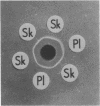Abstract
Purified human platelets were found to contain a collagenase inhibitor that is immunologically, functionally, and chromatographically identical to that produced by human skin fibroblasts. None of the other formed elements of the blood (erythrocytes, granulocytes, mononuclear cells) possessed detectable quantities of this protein. Virtually all the collagenase inhibitor contained within platelets was released following platelet activation with thrombin. Similarly, platelet activation accompanying blood clotting also resulted in the release of this protein, the ratio of plasma to serum inhibitor levels being approximately equal to 0.5. When platelets were subjected to subcellular fractionation, essentially all of the platelet-associated collagenase inhibitor was found to be located in the alpha-granule. Studies with radiolabeled inhibitor failed to detect uptake of inhibitor by platelets. Furthermore, immunologically reactive protein of similar quantity to that found in platelets was identified in human megakaryocyte lysates. Thus, the data suggest that the collagenase inhibitor is endogenously produced and stored within platelet alpha-granules. The platelet-derived collagenase inhibitor was antigenically identical to the collagenase inhibitor from human skin fibroblasts in double immunodiffusion and, like its fibroblast counterpart, inhibited collagenase on a 1:1 stoichiometric basis. When subjected to several of the chromatographic procedures utilized to purify the fibroblast protein, the platelet inhibitor behaved in an indistinguishable manner. Platelet factor 4, previously reported to be a collagenase inhibitor, was found to be immunologically unrelated to the platelet-derived collagenase inhibitor. Furthermore, platelet factor 4 displayed no collagenase inhibitory activity. Although the function of platelet-derived collagenase inhibitor is unknown, such a protein released by activated platelets may serve to regulate collagen turnover during the early stages of the inflammatory process.
Full text
PDF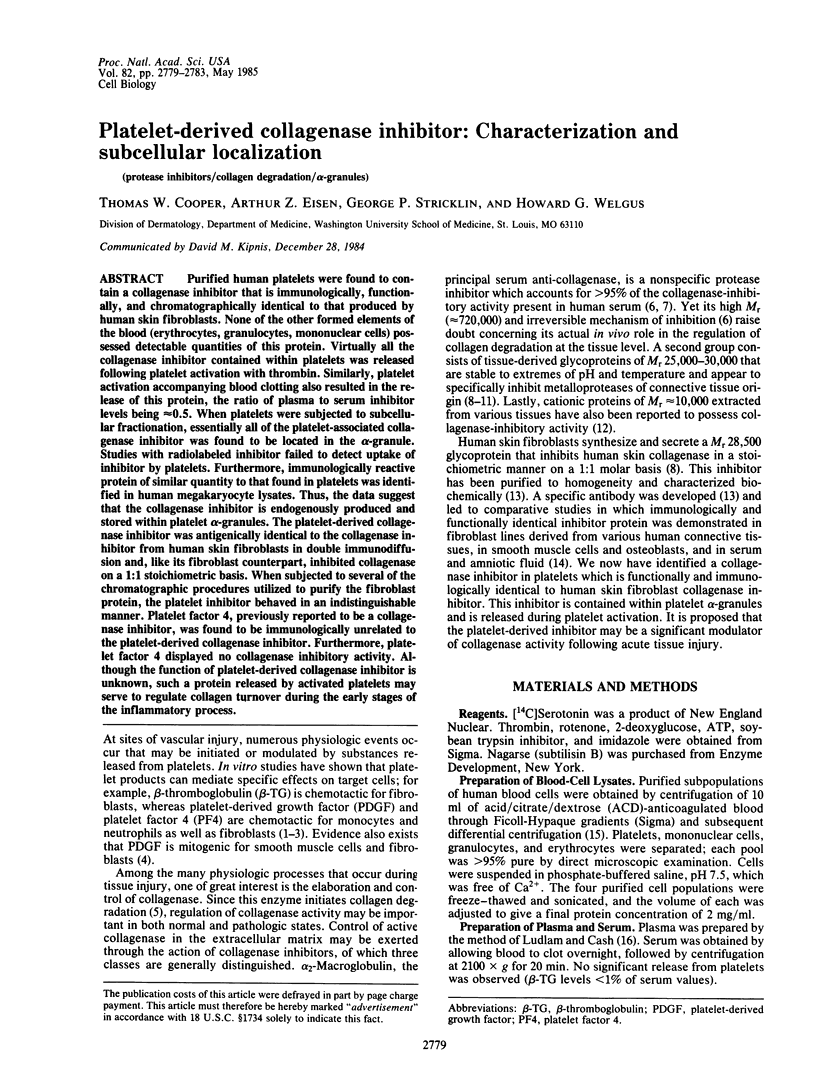
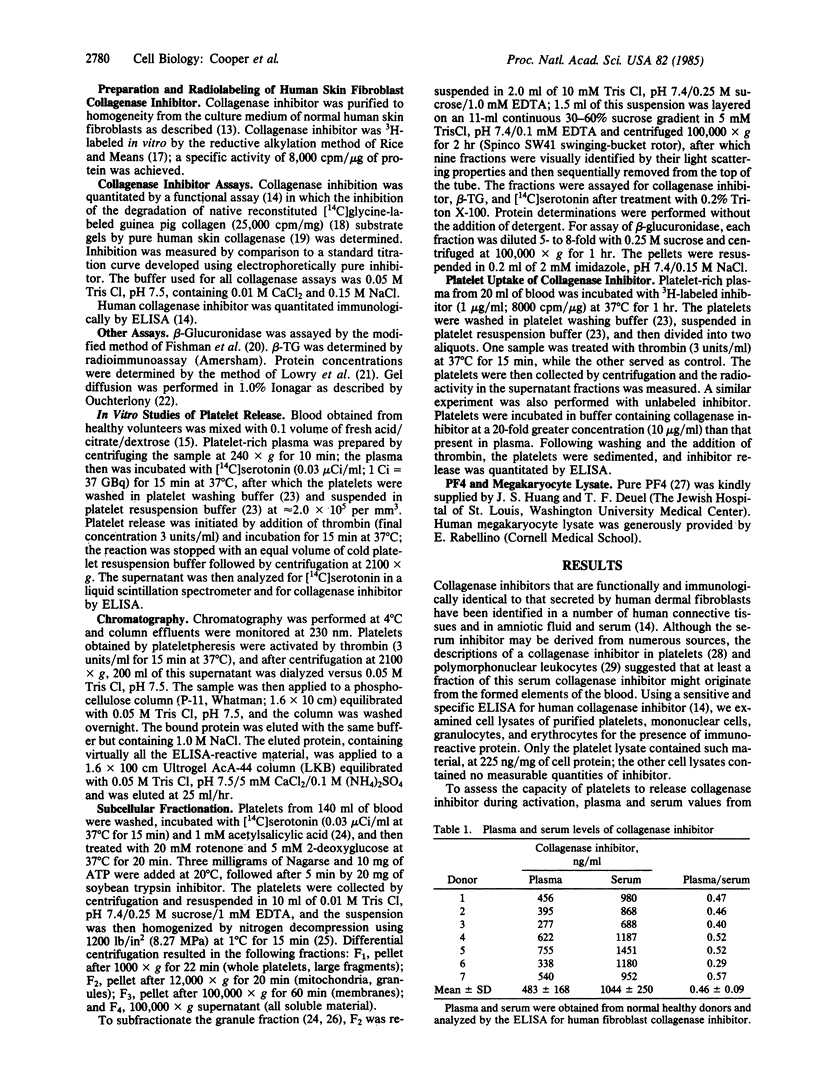
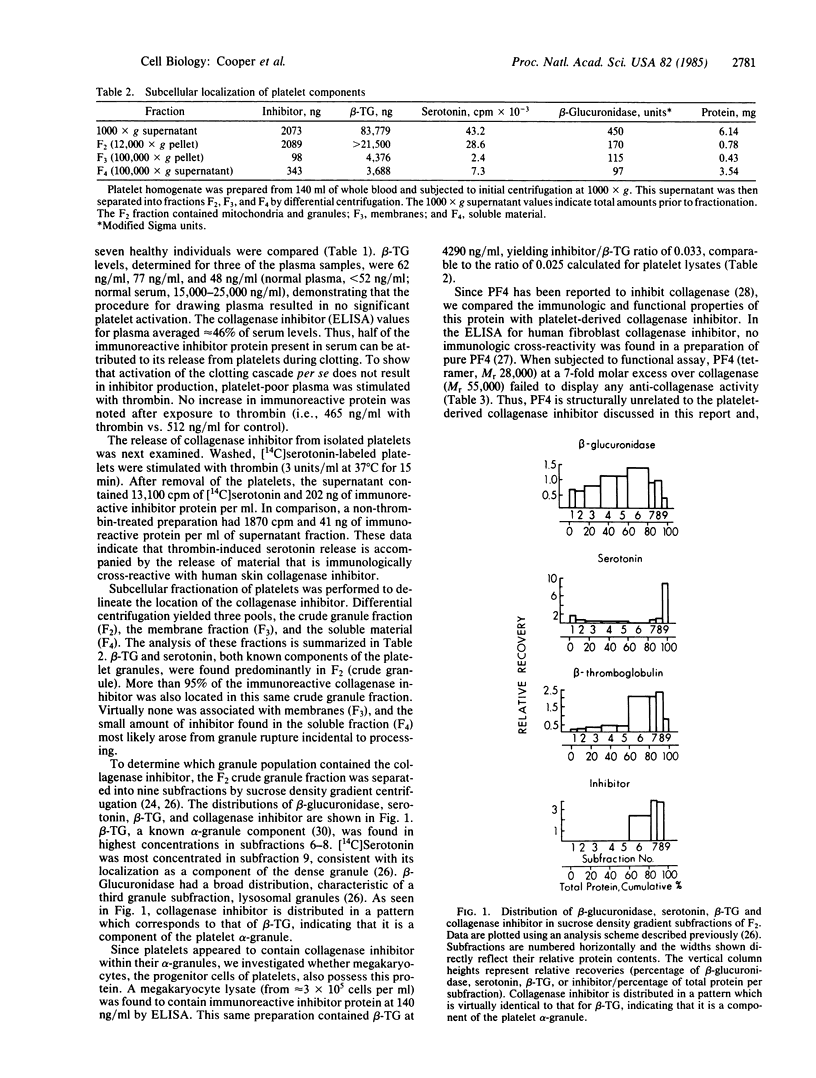
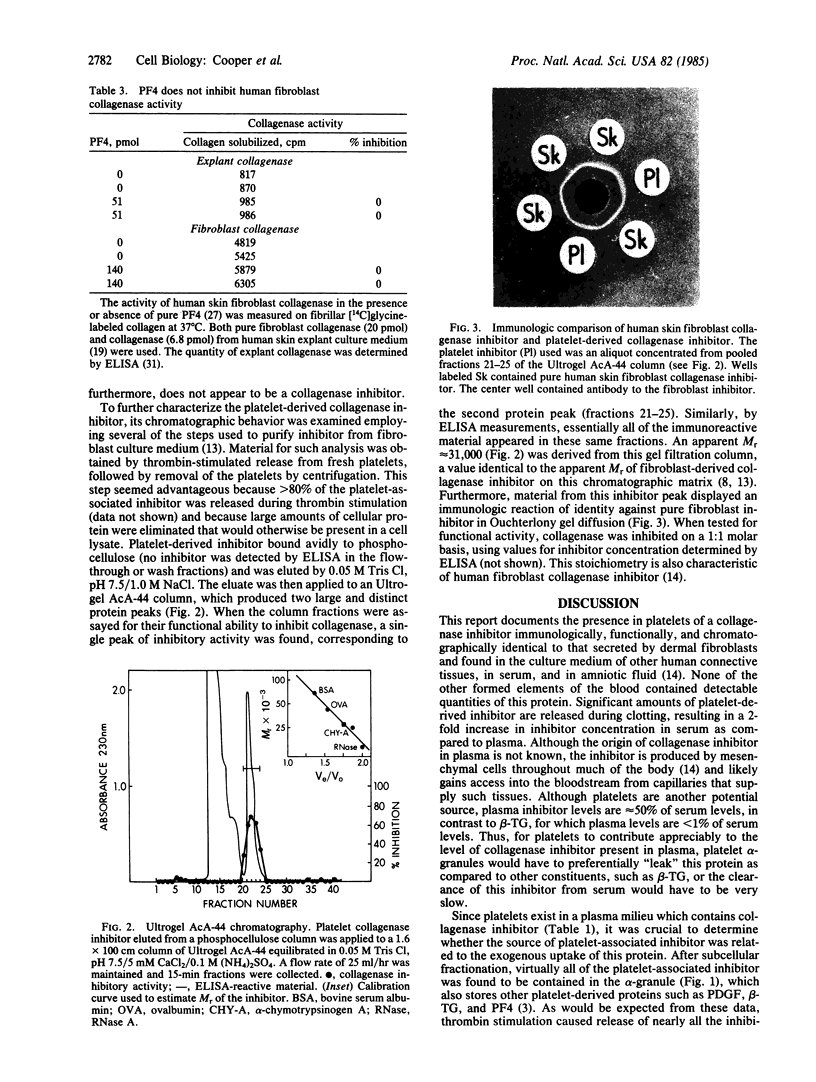
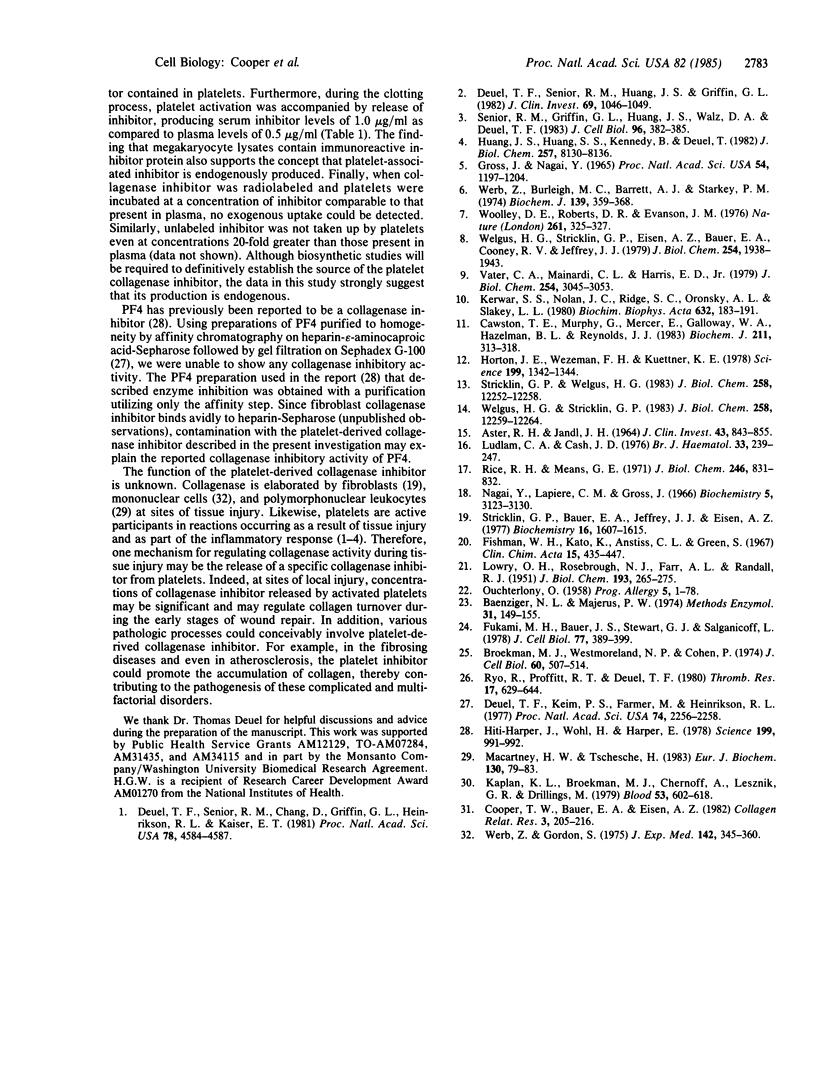
Images in this article
Selected References
These references are in PubMed. This may not be the complete list of references from this article.
- ASTER R. H., JANDL J. H. PLATELET SEQUESTRATION IN MAN. I. METHODS. J Clin Invest. 1964 May;43:843–855. doi: 10.1172/JCI104970. [DOI] [PMC free article] [PubMed] [Google Scholar]
- Baenziger N. L., Majerus P. W. Isolation of human platelets and platelet surface membranes. Methods Enzymol. 1974;31:149–155. doi: 10.1016/0076-6879(74)31015-4. [DOI] [PubMed] [Google Scholar]
- Broekman M. J., Westmoreland N. P., Cohen P. An improved method for isolating alpha granules and mitochondria from human platelets. J Cell Biol. 1974 Feb;60(2):507–519. doi: 10.1083/jcb.60.2.507. [DOI] [PMC free article] [PubMed] [Google Scholar]
- Cawston T. E., Murphy G., Mercer E., Galloway W. A., Hazleman B. L., Reynolds J. J. The interaction of purified rabbit bone collagenase with purified rabbit bone metalloproteinase inhibitor. Biochem J. 1983 May 1;211(2):313–318. doi: 10.1042/bj2110313. [DOI] [PMC free article] [PubMed] [Google Scholar]
- Cooper T. W., Bauer E. A., Eisen A. Z. Enzyme-linked immunosorbent assay for human skin collagenase. Coll Relat Res. 1983 May;3(3):205–215. doi: 10.1016/s0174-173x(83)80004-1. [DOI] [PubMed] [Google Scholar]
- Deuel T. F., Keim P. S., Farmer M., Heinrikson R. L. Amino acid sequence of human platelet factor 4. Proc Natl Acad Sci U S A. 1977 Jun;74(6):2256–2258. doi: 10.1073/pnas.74.6.2256. [DOI] [PMC free article] [PubMed] [Google Scholar]
- Deuel T. F., Senior R. M., Chang D., Griffin G. L., Heinrikson R. L., Kaiser E. T. Platelet factor 4 is chemotactic for neutrophils and monocytes. Proc Natl Acad Sci U S A. 1981 Jul;78(7):4584–4587. doi: 10.1073/pnas.78.7.4584. [DOI] [PMC free article] [PubMed] [Google Scholar]
- Deuel T. F., Senior R. M., Huang J. S., Griffin G. L. Chemotaxis of monocytes and neutrophils to platelet-derived growth factor. J Clin Invest. 1982 Apr;69(4):1046–1049. doi: 10.1172/JCI110509. [DOI] [PMC free article] [PubMed] [Google Scholar]
- Fishman W. H., Kato K., Anstiss C. L., Green S. Human serum beta-glucuronidase; its measurement and some of its properties. Clin Chim Acta. 1967 Mar;15(3):435–447. doi: 10.1016/0009-8981(67)90008-3. [DOI] [PubMed] [Google Scholar]
- Fukami M. H., Bauer J. S., Stewart G. J., Salganicoff L. An improved method for the isolation of dense storage granules from human platelets. J Cell Biol. 1978 May;77(2):389–399. doi: 10.1083/jcb.77.2.389. [DOI] [PMC free article] [PubMed] [Google Scholar]
- Gross J., Nagai Y. Specific degradation of the collagen molecule by tadpole collagenolytic enzyme. Proc Natl Acad Sci U S A. 1965 Oct;54(4):1197–1204. doi: 10.1073/pnas.54.4.1197. [DOI] [PMC free article] [PubMed] [Google Scholar]
- Hiti-Harper J., Wohl H., Harper E. Platelet factor 4: an inhibitor of collagenase. Science. 1978 Mar 3;199(4332):991–992. doi: 10.1126/science.203038. [DOI] [PubMed] [Google Scholar]
- Horton J. E., Wezeman F. H., Kuettner K. E. Inhibition of bone resorption in vitro by a cartilage-derived anticollagenase factor. Science. 1978 Mar 24;199(4335):1342–1345. doi: 10.1126/science.204011. [DOI] [PubMed] [Google Scholar]
- Huang J. S., Huang S. S., Kennedy B., Deuel T. F. Platelet-derived growth factor. Specific binding to target cells. J Biol Chem. 1982 Jul 25;257(14):8130–8136. [PubMed] [Google Scholar]
- Kaplan K. L., Broekman M. J., Chernoff A., Lesznik G. R., Drillings M. Platelet alpha-granule proteins: studies on release and subcellular localization. Blood. 1979 Apr;53(4):604–618. [PubMed] [Google Scholar]
- Kerwar S. S., Nolan J. C., Ridge S. C., Oronsky A. L., Slakey L. L. Properties of a collagenase inhibitor partially purified from cultures of smooth muscle cells. Biochim Biophys Acta. 1980 Oct 1;632(2):183–191. doi: 10.1016/0304-4165(80)90076-8. [DOI] [PubMed] [Google Scholar]
- LOWRY O. H., ROSEBROUGH N. J., FARR A. L., RANDALL R. J. Protein measurement with the Folin phenol reagent. J Biol Chem. 1951 Nov;193(1):265–275. [PubMed] [Google Scholar]
- Ludlam C. A., Cash J. D. Studies on liberation of beta-thromboglobulin from human platelets in vitro. Br J Haematol. 1976 Jun;33(2):239–247. doi: 10.1111/j.1365-2141.1976.tb03535.x. [DOI] [PubMed] [Google Scholar]
- Macartney H. W., Tschesche H. The collagenase inhibitor from human polymorphonuclear leukocytes. Isolation, purification and characterisation. Eur J Biochem. 1983 Jan 17;130(1):79–83. doi: 10.1111/j.1432-1033.1983.tb07119.x. [DOI] [PubMed] [Google Scholar]
- Nagai Y., Lapiere C. M., Gross J. Tadpole collagenase. Preparation and purification. Biochemistry. 1966 Oct;5(10):3123–3130. doi: 10.1021/bi00874a007. [DOI] [PubMed] [Google Scholar]
- OUCHTERLONY O. Diffusion-in-gel methods for immunological analysis. Prog Allergy. 1958;5:1–78. [PubMed] [Google Scholar]
- Rice R. H., Means G. E. Radioactive labeling of proteins in vitro. J Biol Chem. 1971 Feb 10;246(3):831–832. [PubMed] [Google Scholar]
- Ryo R., Proffitt R. T., Deuel T. F. Human platelet factor 4: subcellular localization and characteristics of release from intact platelets. Thromb Res. 1980 Mar 1;17(5):629–644. doi: 10.1016/0049-3848(80)90366-7. [DOI] [PubMed] [Google Scholar]
- Senior R. M., Griffin G. L., Huang J. S., Walz D. A., Deuel T. F. Chemotactic activity of platelet alpha granule proteins for fibroblasts. J Cell Biol. 1983 Feb;96(2):382–385. doi: 10.1083/jcb.96.2.382. [DOI] [PMC free article] [PubMed] [Google Scholar]
- Stricklin G. P., Bauer E. A., Jeffrey J. J., Eisen A. Z. Human skin collagenase: isolation of precursor and active forms from both fibroblast and organ cultures. Biochemistry. 1977 Apr 19;16(8):1607–1615. doi: 10.1021/bi00627a013. [DOI] [PubMed] [Google Scholar]
- Stricklin G. P., Welgus H. G. Human skin fibroblast collagenase inhibitor. Purification and biochemical characterization. J Biol Chem. 1983 Oct 25;258(20):12252–12258. [PubMed] [Google Scholar]
- Vater C. A., Mainardi C. L., Harris E. D., Jr Inhibitor of human collagenase from cultures of human tendon. J Biol Chem. 1979 Apr 25;254(8):3045–3053. [PubMed] [Google Scholar]
- Welgus H. G., Stricklin G. P., Eisen A. Z., Bauer E. A., Cooney R. V., Jeffrey J. J. A specific inhibitor of vertebrate collagenase produced by human skin fibroblasts. J Biol Chem. 1979 Mar 25;254(6):1938–1943. [PubMed] [Google Scholar]
- Welgus H. G., Stricklin G. P. Human skin fibroblast collagenase inhibitor. Comparative studies in human connective tissues, serum, and amniotic fluid. J Biol Chem. 1983 Oct 25;258(20):12259–12264. [PubMed] [Google Scholar]
- Werb Z., Burleigh M. C., Barrett A. J., Starkey P. M. The interaction of alpha2-macroglobulin with proteinases. Binding and inhibition of mammalian collagenases and other metal proteinases. Biochem J. 1974 May;139(2):359–368. doi: 10.1042/bj1390359. [DOI] [PMC free article] [PubMed] [Google Scholar]
- Werb Z., Gordon S. Secretion of a specific collagenase by stimulated macrophages. J Exp Med. 1975 Aug 1;142(2):346–360. doi: 10.1084/jem.142.2.346. [DOI] [PMC free article] [PubMed] [Google Scholar]
- Woolley D. E., Roberts D. R., Evanson J. M. Small molecular weight beta 1 serum protein which specifically inhibits human collagenases. Nature. 1976 May 27;261(5558):325–327. doi: 10.1038/261325a0. [DOI] [PubMed] [Google Scholar]



